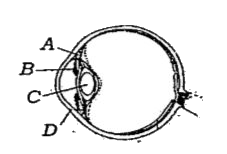Calculate the hydrogen ion concentration in the following biological fluids whose pH are given below :
(a) Human muscle – fluid, 6.83
(b) Human stomach fluid, 1.2
(c) Human blood, 7.38
(d) Human saliva, 6.4
To calculate the hydrogen ion concentration in various biological fluids based on their pH values, we can use the formula:
pH=−log(H+)
From this, we can derive the hydrogen ion concentration (H+) as follows:
(H+)=10−pH
Now, let's calculate the hydrogen ion concentration for each fluid step by step.
(a) Human Muscle Fluid, pH = 6.83
1. Calculate (H+):
(H+)=10−6.83
2. Antilog Calculation:
- Break down the calculation:
- The integer part is -6, and the decimal part is -0.83.
- We can express it as:
(H+)=10−6×10−0.83
- Calculate 10−0.83:
- 10−0.83≈0.17 (using logarithmic tables or calculators).
3. Final Calculation:
(H+)=0.17×10−6=1.7×10−7M
(b) Human Stomach Fluid, pH = 1.2
1. Calculate (H+):
(H+)=10−1.2
2. Antilog Calculation:
- Break down the calculation:
(H+)=10−1×10−0.2
- Calculate 10−0.2:
- 10−0.2≈0.63.
3. Final Calculation:
(H+)=0.63×10−1=6.3×10−2M
(c) Human Blood, pH = 7.38
1. Calculate (H+):
(H+)=10−7.38
2. Antilog Calculation:
- Break down the calculation:
(H+)=10−7×10−0.38
- Calculate 10−0.38:
- 10−0.38≈0.42.
3. Final Calculation:
(H+)=0.42×10−7=4.2×10−8M
(d) Human Saliva, pH = 6.4
1. Calculate (H+):
(H+)=10−6.4
2. Antilog Calculation:
- Break down the calculation:
(H+)=10−6×10−0.4
- Calculate 10−0.4:
- 10−0.4≈0.40.
3. Final Calculation:
(H+)=0.40×10−6=4.0×10−7M
Summary of Results:
- (a) Human Muscle Fluid: (H+)=1.7×10−7M
- (b) Human Stomach Fluid: (H+)=6.3×10−2M
- (c) Human Blood: (H+)=4.2×10−8M
- (d) Human Saliva: (H+)=4.0×10−7M
(H+)=10−6.83
- Break down the calculation:
- The integer part is -6, and the decimal part is -0.83.
- We can express it as:
(H+)=10−6×10−0.83
- Calculate 10−0.83:
- 10−0.83≈0.17 (using logarithmic tables or calculators).
(H+)=0.17×10−6=1.7×10−7M
(H+)=10−1.2
- Break down the calculation:
(H+)=10−1×10−0.2
- Calculate 10−0.2:
- 10−0.2≈0.63.
(H+)=0.63×10−1=6.3×10−2M
(H+)=10−7.38
- Break down the calculation:
(H+)=10−7×10−0.38
- Calculate 10−0.38:
- 10−0.38≈0.42.
(H+)=0.42×10−7=4.2×10−8M
(H+)=10−6.4
- Break down the calculation:
(H+)=10−6×10−0.4
- Calculate 10−0.4:
- 10−0.4≈0.40.
(H+)=0.40×10−6=4.0×10−7M
- (a) Human Muscle Fluid: (H+)=1.7×10−7M
- (b) Human Stomach Fluid: (H+)=6.3×10−2M
- (c) Human Blood: (H+)=4.2×10−8M
- (d) Human Saliva: (H+)=4.0×10−7M
Similar Questions
Calculate the hydrogen ion concentration in the following biological fluids whose pH are given below :
(a) Human muscle – fluid, 6.83
(b) Human stomach fluid, 1.2
(c) Human blood, 7.38
(d) Human saliva, 6.4
View SolutionCalculate the hydrogen ion concentration in the fol- lowing biological fluids whose pH are given below -
Human muscle-fluid 6.86
View Solution
Knowledge Check
pH of human blood is 7.4. Then H+ concentration will be
A4×10−8B2×10−8C4×10−4D2×10−4In the diagram of human eye given below, the parts marked by A, B, C and D should be labelled as
 AA-iris, B-cornea, C-pupil, D-lensBA-ciliary muscle, B-iris, C-lens, D-corneaCA-ciliary muscle, B-pupil, C-lens, D-corneaDA-iris, B-pupil, C-lens, D-cornea
AA-iris, B-cornea, C-pupil, D-lensBA-ciliary muscle, B-iris, C-lens, D-corneaCA-ciliary muscle, B-pupil, C-lens, D-corneaDA-iris, B-pupil, C-lens, D-corneaIn the diagram of human eye given below, the parts marked by A, B, C and D should be labelled
 AA-ciliary muscle -BH-pupil, C-lens, D-corneaBA-iris, B-pupil, C-lens, D-corneaCA-iris, B-cornea, C-pupil, D-lensDA-ciliary muscle, B-iris, C-lens, D-cornea
AA-ciliary muscle -BH-pupil, C-lens, D-corneaBA-iris, B-pupil, C-lens, D-corneaCA-iris, B-cornea, C-pupil, D-lensDA-ciliary muscle, B-iris, C-lens, D-cornea
Write one function each of the following components of the circulatory system in humans.
(a) Blood vessels , (b) Blood platelets
(c )Lymphy , (d) Heart
View SolutionIn how many of the following organisms sprem will decide the sex of progenies? (1) Grasshopper (2) Drosophila (3) Bird (4) Butterflies (5) Moths (6) Humans
View SolutionWhich of the following organisms does not have both muscles and skeleton for movement? A. Dog B. Snail C. Earthworm D. Human being
View SolutionDraw a neat diagram of the human male reproductive system and label the parts performing the following functions :
(a) Production of sperms.
(b) Gland which provides fluid.
(c) Provides low temperature for the formation of sperms.
(d) Common passage for sperms and urine.
View SolutionWrite the following decimals as fractions. Reduce the fractions to lowest form.(a) 0.6 (b) 2.5 (c) 1.0 (d) 3.8 (e) 13.7 (f) 21.2 (g) 6.4
View Solution
